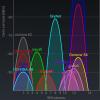Full HD is high definition video. It is used for broadcasts with HDTV resolution.
The resolution of Full HD video systems is 1280x720 and 1920x1080 pixels, the sides are aspect ratio 16: 9. In standard definition (SD) video, the aspect ratio is 4: 3. High definition is achieved by increasing the detail of the picture by five times. Standard definition of the image - individual points 720x576 = 414720. The number of pixels for HD720 format increases to 1280x720 = 921600, and for HD1080 - 1920x1080 = 2073600, or two megapixels. This is n times standard definition. Most manufacturers are not very knowledgeable about what Full HD is. They talk about 6 megapixels on TVs. This is not entirely correct, it is more accurate to say that there are 6 million subpixels. After all, each color pixel has three subpixels with basic colors, such as:
Red;
Green;
Interlaced supports frames with the following rates: 25, 29.97, 30 per second.

Progressive scan controls frames 50, 59.94, 60.
Thus, movies in HD are 24 frames per second.
The designation HD720 / 24p stands for a frame with a resolution of 1280x720 pixels, because of the progressive scan 24 frames per second, HD 1080 / 29.97i is a frame of 1920x1080, thanks to interlaced scanning - 29.97 frames.

Just don't confuse frame rate with 100Hz on TVs. At higher scanning frequencies, the same frames are shown several times. In cinema, to reduce flickering, each frame is shown twice (48 Hz), and 24 different frames in just a second.
Statistics, statistics, and what Full HD is, you need to be convinced by your own experience.
On a Full HD panel with a quality signal source, high definition video is quite evident.
How is it achieved?
1. The detail of the picture is improved five times. It is provided with a large number of dots that make up the image.
2. The frame contains more information. Small details do not merge into a solid background.
3. The texture of the materials is better developed. Grass, fur, frost patterns have become clearer. The resulting image is more realistic. Now you know what Full HD is. high definition video of all formats, up to the maximum - 1920x1080. If the matrix that is part of the TV or panel comes with a resolution of 1280, 1336, 1440, then there can be no talk of Full HD. Such matrices allow to display the maximum HD720 - it is HD-Ready.
The differences between HD-Ready and Full HD are as follows:
1. There is no guarantee that a TV without marking with a matrix of 1280 pixels or more in width will clearly show. Rather, such a device displays SD signals. It interpolates the standard clear signal "up", increasing the SD base resolution to the physical resolution of the sensor.
2. HD-Ready marking allows viewing of standard and high definition video.
3. Full-HD allows you to display SD, HD, HD 1080. Usually, these TVs are equipped with more powerful video processors, which allows you to watch HD movies in high quality directly at home. Manufacturers are trying to equip Full matrices, so they have the highest price range.
Based on all of the above, you can answer the question of what Full HD is. This is a really high quality image that is always a pleasure to look at!
The quality of the image on the phone screen depends not only on the screen resolution and pixel density
The smartphone's 2K screen resolution sounds attractive. It is 2560 x 1440 pixels. But is it necessary? Ever since Apple began equipping its devices with Retina Displays and touting image density, many have placed a lot of emphasis on “ppi” (pixels per inch). The higher the pixel density, the sharper the image. But this indicator is far from the only one that affects the quality of the screen. It also happens that the picture on a qVGA-display (960 x 540 pixels) looks better than on an HD-screen (1280 x 720). And some HD displays are better than others FullHD (1920 x 1080). Why it happens?

Screen resolution is an important, but not the only factor affecting the quality of a display device.
Vijay Srivastava's article “HD or FullHD? Coming To A Resolution On Mobile Screens (Good displays aren’t only about pixels ...) ”. A good display isn't just about pixels!
Mobile phone display quality depends on various factors, not just pixel density. The type of panel used is important. You’ve seen AMOLED, LCD and IPS more than once. The image processor also plays a role, as exemplified by the Sony Mobile Bravia Engine. Even the type of scratch-resistant glass also has an effect on the quality of the display. It is this combination of several factors that determines how good an image will look on the screen.
Why is there so much talk about pixels?
The reason is simple - there is a dry number and an opportunity to say: "The more the better." A simple explanation is always the most understandable, but not always accurate enough. To the same extent, in relation to cameras, they often talk about the resolution of their matrices ("megapixel"), and not about some other parameters. For this reason, many users mistakenly believe that the higher the “megapixel”, the better the camera. Meanwhile .
Similarly, for displays, the most common pixel density rating does not reflect all aspects of screen quality. This explanation is the easiest to understand and for this reason the most popular.
Testing in reality
It often happens that distinguishing an HD screen from a FullHD screen is very difficult when it comes to a display with a diagonal of about 5 inches. To notice the difference, you will have to carefully study the screen. Most people hold the phone at the level of their elbows, perhaps a little closer. From this distance, the difference between HD and FullHD screens is not easy to notice. If you look closely, these differences can be found, but in the process of everyday use of the device, they will not play a significant role.
Vijay Srivastava bases his opinion on testing eight 5-inch and one 5.2-inch phones and comparing them with each other. Some of these phones were HD and others were FullHD. He compared them on the same games and e-books and came to the conclusion that most people simply cannot see the differences. Game performance depends a lot on.
He repeated this test with the Samsung Galaxy Grand 2's 5.2-inch HD display and compared it to the Micromax Canvas Turbo's 5-inch FullHD display. Vijay Srivastava asked people for their opinion on which phone has the best screen. Of the 13 people who were shown both phones, 12 felt the Grand 2's display was better. The reasons were named that he has "better color" and he "looks brighter". It so happened that the screen with a lower resolution was called better by most of those who had the opportunity to compare.
What does this mean for the user?
Therefore, screen resolution and pixel density alone are not determinants of screen quality. In some cases, when the difference is significant, if, for example, comparing WVGA- (800 x 480 pixels) with an HD-screen. But if we talk about the mainstream 5-inch screen of a modern smartphone, then distinguishing an HD screen from a FullHD display will be difficult. If the screen size is larger (6-inch), then the difference in FullHD quality is likely to be more noticeable.

Pixel density and screen resolution are not the only factors affecting image quality
Therefore, when purchasing your next phone with a screen of about 5 inches, the user will most likely be satisfied with an HD screen with a resolution of 1280 x 720 pixels and it is advisable to pay attention to other characteristics of the device - its processor and RAM. Although Sharp and, such a large resolution can.
How many users, not knowing the exact characteristics of the device, will be able to immediately determine the resolution of a 5-inch smartphone screen (HD or FullHD)?
There were times when users enjoyed DVD quality movies. Nowadays, TVs that display a high-definition Full HD picture have become widespread. Although there are already models on the market that can display highly detailed images in Ultra HD resolution, they are not yet very popular due to the high price.
When listing all the features and technical features of a particular TV, a sales consultant will probably mention that it is capable of playing high-definition video. Almost all new TVs are capable of playing Full HD video, but not all users know what Full HD is. This article will help you understand this issue. I would like to explain that when it comes to high-definition video, first of all, it means a five-fold increase in image detail.
Such a multiple improvement in quality is ensured by the fact that the number of pixels from which the picture is formed increases. High definition video has two main resolution formats. These are 1920 × 1080 pixels and 1280 × 720 pixels. In both the first and second cases, the aspect ratio of the image is 16: 9. As a reminder, standard definition video uses an aspect ratio of 4: 3. If you take the pixel sizes the same, then you can visually compare the Full HD standard with other standards.

Advantages of the standard Full HD
Before we figure out what Full HD is, let's find out the main advantages that high-definition video is fraught with. Talking about higher resolutions and, as a result, getting a more detailed image is good, but you need to see a real increase in picture performance when choosing a Full HD TV yourself. With a high-quality video source, Full HD panels display an excellent picture, which is much superior to the display result of SD TVs. What explains this superiority?

Much of the credit lies in the five times improved detail, which is easily provided by the increased number of dots that form the image. Each Full HD frame contains an increased amount of information and, as a result, there is a deep study of small details that are not lost against the general background. Now you can distinguish between small veins on foliage, individual hairs on animal fur, impressive frosty patterns. Such detailing gives the picture realism and it is noticeable. Particularly well-enhanced detail is seen on large-screen TVs. On the large display, all errors and inaccuracies related to the quality of the picture are very clearly visible.
FullHDas it is
Now it's time to decide what Full HD is. To be correct, Full HD is a marketing name that means that the TV supports all high definition video formats up to 1920 × 1080. This means that if the matrix of the TV has a lower resolution (1280, 1336 or 1440 pixels in width), then there can be no question of the Full HD standard. Lower resolution matrices are capable of displaying video in full HD720 quality. On such models, it is usually present, which can be conditionally deciphered as "ready for display" HD. Next, let's look at the real differences between TVs with and without Full HD or HD Ready.
- If there is no marking on the TV, then even the presence of a high-definition matrix does not give any guarantee about support for high-definition video. In most cases, these TVs are designed to display a standard SD signal at its maximum resolution, up to the level supported by the matrix. As a result, the maximum SD resolution will be equal to the physical resolution of the matrix.
- If your TV is marked HD Ready, it means it can play HD and SD video. That is, the resolution of the HD1080 signal will be reduced to the real resolution of the matrix, the HD720 signal will be displayed "as is" (if the resolution of the TV matrix is 1280 × 720) or its resolution will be increased (if the resolution of the matrix is more than 1280 × 720), the resolution of the SD signal will also will be increased to the actual resolution of the matrix.
- If the TV is marked as Full HD, it means that it can display any signal, be it SD or HD. HD1080 quality signal is displayed as is, while the resolution of other signals will be increased.
As a rule, TVs that support the Full HD standard are equipped with more efficient and powerful processors. Modern electronic "stuffing" without any problems allows the TV to interpolate the HD720 and even SD signal, increasing their quality. From this it follows that if you need to give preference to Full HD models that have great opportunities in the field of high-quality picture display.
Output
We have analyzed in detail what Full HD is and found out the main advantages that high-definition video brings. In view of the emergence and gradual spread of ultra-high definition Ultra HD TVs, Full HD TVs are already the norm and the price for such devices is available to everyone. Even budget models are often equipped with Full HD matrices. Now you know what Full HD is and similar markings in the TV store will not cause confusion.
When we are proudly shown TVs, monitors, displays labeled FullHD, this "highest" resolution seems to be the highest blessing. But high-definition television or HD video came to us relatively recently, so they have not yet had time to demand replacement in accordance with the technology update. Naturally, with a sometimes rather insignificant difference in price, for example, for FullHD and HD ready TVs, the consumer wants to know exactly what he is buying and whether he made a mistake in his choice. The displayed pictures do not always make it possible to determine: the image quality depends not only on the resolution, but also on many other factors (brightness, contrast, viewing angles of the screen, etc.), and subjective opinion is again marking time. Let's see what is the difference between the main baits of television and video equipment - FullHD and HD resolutions.
Definition
HD Resolution Standard(High Definition) includes any resolution that exceeds the standard format (i.e. 720x576). Today, HD resolution (HD ready) means the minimum requirements for a resolution of 1280x720, however, less common resolutions, for example, 1920x1440, are also referred to the high-definition standard. Marketing also introduces the HD ready designation to denote matrices capable of displaying the HD standard on a par with standard definition.
In fact, Full HD- This is HD with a resolution of 1920 × 1080, that is, higher than HD.
Comparison
The Full HD naming is not a quality standard - it is a marketing tag designed to attract shoppers and keep them from getting confused by the digital values of the resolutions. There is a standard HD ready 1080p, corresponding to a resolution of 1920 × 1080, but not equivalent to Full HD: often video equipment technically does not correspond to the mentioned standard, being limited to compliance with the resolution. HD ready, on the other hand, is a standardized designation for receivers.
For the consumer, the difference between Full HD and HD is in the picture quality. High definition is due to the increase in detail by increasing the number of pixels of the screen matrix. Consequently, a Full HD picture contains more information than an HD or standard definition picture. According to experts, the difference in the amount of information can reach fourfold.
Also, Full HD display matrices are capable of displaying both a picture with a resolution of 1920 × 1080 and 1920 × 720, and a standard 720 × 576, while HD ready does not aim at a higher resolution. This does not mean that when playing a video of a different format, we will get a TV grid or "snow". HD displays increase the standard video resolution to the resolution of the installed matrix, the HD720 picture is displayed unchanged, and the HD1080 is reduced - again, to the physical capabilities of the matrix. Full HD-displays any resolution below 1920х1080 "hold out" to their own matrix. As a rule, large screens involve the reproduction of media content, so the picture quality will be of fundamental importance, and the choice remains with Full HD.
As far as scanning is concerned, HD means extremely progressive, although with a little distortion, such devices can reproduce (interlaced). FullHD assumes both interlaced and progressive scanning. This compromise makes it possible to receive a signal, for example, from a satellite without problems with data flow and channel capacity.
Today, the price range of television and video equipment has a very wide spread, so there is no reason to talk about a clear advantage in the cost of one or another class of devices. However, most manufacturers, in addition to Full HD matrices, install powerful processors that can process images quickly, so if the diagonals are equal, such models can be significantly more expensive. Another important point: Full HD is not equal to HD1080p, so TV and monitor models that technically do not meet the quality standard can be labeled Full HD (without deceiving potential buyers), but such devices are much cheaper than those labeled HD1080p.
Conclusions site
- The minimum resolution of Full HD matrices is 1920 x 1080, while HD is 1920 x 720.
- The picture quality on Full HD displays is higher than on HD.
- The HD ready standard imposes high technical requirements on technology (with the exception of the matrix resolution), the Full HD marking is actually responsible only for the resolution.
- Full HD supports interlaced scanning without altering the picture.
- Full HD may not meet the HD1080p quality standard.
- Manufacturers often equip Full HD devices with powerful processors, which affects functionality and performance.
Dear readers of the NskTarelka.ru blog, the question is - Full hd or ultra hd, which is better? - it would seem that it is already rhetorical in itself. But rhetoric is rhetoric, and suddenly- Not all that glitters is gold. Or - The fox's cunning in the stupidity of chickens. Or - a woman with a cart, it is easier for a mare. Sorry, this is personal about the woman and the mare. Freudian slip.
We all know that in life everyone has their own answer to any question. Therefore, there will be no statements in this article. Just some additional information:
What is the difference between full hd and ultra hd;
- 4K resolution is how much;
- what is upsailing;
- and etc.
And after reading the article, we will remain with our opinion, perhaps we will change it, or just formulate, about whether - is it worth buying 4k uhd TVs?
4k or full hd what to choose?
What is a pixel
About the pixel, if you try very hard, you can even write a poem. But this is not required for this article. Just briefly, I will give information in a simplified form for those who do not know what it is.
A pixel is the smallest unit of a bitmap. A picture for visual perception of the issue under discussion is attached.
The quality of the picture displayed on the TV screen depends on the number of pixels displayed vertically and horizontally. The more pixels an image contains, the more detailed it is.
All of the above regarding image quality is valid if certain conditions are met. Which ones? Correctly selected ratio of the diagonal of the TV, taking into account the distance between it and the viewer (s). And the source of the received content (TV signal source). We will dwell on this in more detail below.
What are the differences between Full HD and Ultra HD?
Before looking for the differences between Full HD and Ultra HD, it's worth reminding you that neither Full HD nor Ultra HD are quality standards. These are just marketing titles. And Full fullu strife, as well as ultra ultra.


Full HD - resolution of 1920 × 1080 dots (pixels). The term was first coined by Sony in 2007. Other manufacturers picked up the name and it stuck as a marketing tag, as a popular name for a format regulated by the ITU-R BT.709 standard.
That is, if the product, in our case, the TV, meets the minimum requirements of the ITU-R BT.709 standard for this particular category, then the manufacturer proudly, legally, stamped a Full HD nameplate on its box.
The colorful Full HD inscription on the box with the TV tells us that we can comfortably watch almost any available content with a resolution of 1920 × 1080 pixels. That is, we watch Full HD content one-to-one, as it is, and HD and SD with upscaling.
Upscaling - scaling of the received content towards its increase. Its quality is inextricably linked with the model of the processor (s) used in the TV.

ULTRA HD

Ultra HD or 4K or 2160p - 3840 x 2160 dots (pixels) resolution.
Good Ultra HD or Ultra High Definition Television includes two digital 4K UHDTV (2160p) and 8K UHDTV (4320p) digital standards proposed by NHK Science & Technical Research Laboratories and adopted by the International Telecommunication Union in August 2012 in accordance with ITU-R Recommendation BT .2020. But 8K UHDTV (4320p) as they say in one famous show - This is a completely different story.
The minimum requirements for Ultra HD technology were approved on October 22, 2012 by the industry organization Consumer Electronics Association (CEA) in the process of anonymous voting of the working group. The requirements according to the official document are as follows: Ultra HD equipment, in our case a TV, must have at least 8 million active pixels. Horizontal at least 3840, vertical at least 2160. Aspect ratio (as for all HD formats) at least 16: 9. The interface must have at least one digital input receiving a video signal with a resolution of 3840 × 2160 pixels. This is HDMI 1.4 or HDMI 2.0 or DisplayPort.

The colorful ULTRA HD 4K lettering on the TV box tells us that we can enjoy watching ultra-high definition content with a resolution of 3840 × 2160 pixels. That is, we watch ULTRA HD 4K content one-on-one, as it is, and SD, HD and Full HD with upscaling.
Choosing the diagonal of the TV taking into account the distance from the viewer to the screen
There are online services for the selection of the panel diagonal. There are many tables. The data is different everywhere. How to be? After all, a wrongly chosen diagonal is a waste of money. The choice of the diagonal of the panel is one of the important parameters, unfortunately, which is often overlooked. For this article, I used the recommendations for choosing a diagonal from the manufacturers' official resources. As "donors" of important information, I chose Sony's company from the land of the rising sun, Samsung represents the Korean side.
Best viewing distance for LCD TV. Recommendations from Sony
Recommended viewing distance for format TVs 4K is an one and a half screen height.
When viewed from this distance with the naked eye, individual pixels cannot be distinguished. This means pixels effectively “fade out” when viewing 4K images. This creates the impression of viewing a television image with the same detail and resolution as in real life.Notes: The appropriate viewing distance depends on the content, viewing conditions, and the physical condition of the viewer. It is recommended to watch TV from a suitable distance with regular breaks.
More details on the Sony website.
As you can see, we are talking about the best distance, but the zone of comfortable viewing from and to is not indicated. Somewhere in the video from Sony came across a standard recommendation for choosing the diagonal of the LCD panel (not Ultra HD 4K). This is the distance of two to three diagonals of the selected panel between the audience and the screen.
The generally accepted recommendation of experts should be considered the following rule: to select the screen size of a Full HD TV, you need to take the distance from the TV to the sofa in meters and multiply it by 25 to get the screen size in inches. For example, a TV located 2 meters from the sofa should have a diagonal of 50 inches. For a distance of 3 meters, you can choose a TV with a diagonal of 75 inches.
For UHD TVs, which are characterized by higher picture quality and detail, the distance from the sofa to the TV should be multiplied by 39. In this case, 78 inches (2 m) should be considered the optimal screen size for a sofa TV distance of 2 meters. And for a distance of 3 meters from the TV to the sofa, the best screen size is 117 inches, i.e. 3 meters!

What is the best distance to watch TV? The International Organization for Standardization ITU-R recommends looking at a 50-inch TV screen from a distance of 2 to 3 meters. If your sofa or armchair is less than two meters away, then you better buy a smaller FHD TV or replace it with a UHD TV, otherwise you will feel discomfort. The picture on a 50 ”UHD TV can be viewed from a distance of one meter without feeling any discomfort. For an 85-inch UHD TV, the optimum distance to the screen is between 1.6 and 3.3 meters.

With the choice of the diagonal, there is more than enough information. It is important to understand that by purchasing an ultra hd 4k panel with a diagonal less than recommended in your case, the effect is - Wow! - you won't get it until you are at your optimal viewing distance.
Is it worth, say, buying a 55-inch 4k uhd TV to watch 4K content from a distance of 3 meters or more? The answer is no. In this case, having a 4k uhd panel with a diagonal of 55 inches and turning on the corresponding content (also 4K), we will see remarkable quality from a distance of three or more meters. But this will not be the quality of Ultra HD 4 Ka, it will already be Full HD. Except that perhaps you have eagle eyesight. How then to be? How to solve this problem?
Or we break the piggy bank and buy a more expensive, but corresponding to the calculations, UHD TV with a diagonal of 85 inches, and watch with comfort 4K content from 1.5 to 3.5 meters. Or the second solution, we turn into a designer, move the furniture, reducing the distance between it and the TV.
For those who decided to buy an ultra hd 4k TV, consider an equally important component than the choice of a diagonal, this is content. As I said earlier, in our case, content is the source (s) of the received TV signal.
Where do the firewood come from? - From the forest, obviously
4K content sources
After visiting the store, and comparing the Full HD and Ultra HD 4K pictures with each other, if you have the financial opportunity, most likely, a spontaneous decision will be as follows - Everything. Resolved. I want to buy an ultra hd 4k TV with the recommended diagonal.
Wonderful. Ultra HD 4K quality is really awesome. The quality of the 4K demo video shown for a potential buyer. This is exactly the case when the content is relevant.
Tricolor Ultra hd
If satellite television under the Tricolor TV brand is available in your region from 36 degrees, you can use Tricolor ultra hd as a source of 4K content.
The operator, on its official website, offers an Ultra HD package for connection. According to the operator, three exclusive and bright ultra-high definition TV channels are offered for viewing:
TRICOLOR ULTRA HD - movies and TV series
It is declared as the first TV channel in Russia broadcasting in 4K Ultra HD format. A wide selection of foreign and Russian cinema.
Tricolor ultra hd software
Fashion One - fashion
TV channel about fashion, entertainment, lifestyle.
Tricolor Fashion One Program
Insight Ultra HD
Reality shows, extreme travel and sports, innovative documentaries, interactive projects.
Insight Ultra HD TV Guide
The subscription fee for the Ultra HD package is 1,200 rubles per year.
I have not seen the channels of this package live, they are not yet available in Novosibirsk. We have the specified brand broadcasting from 56 degrees. And yet, at least doubts creep in about the quality of the content provided on the TRICOLOR ULTRA HD channel. The owner of the channel is Tricolor himself.
What kind of films are broadcast on this channel. Is this content purchased by the company conforming to the standard?
How to activate the Tricolor ultra HD package?
The technical characteristics (capabilities) of the purchased panel must meet certain requirements. You can pay very expensively for the panel, but you will not be able to connect to the ultra HD package. The price of an Ultra HD 4K TV is not an indicator in this case.
What should an Ultra HD panel have and be able to do to connect tricolor 4K content?
To begin with, at the time of publication of this article, the operator does not have receivers that can “read” the 4K format. To view the operator's high-definition television package, you need to purchase a satellite TV set with a CI + conditional access module. The Tricolor TV access card is inserted into the module. And the module is placed in a CI slot with support for the CI + standard

The panel must have a CI slot supporting the CI + standard
As a rule, the next requirement is interconnected with the previous one. That is, if there is the first, then there will be the second, but just in case I will sound it.
The panel must support the DVB-S2 broadcasting standard (satellite broadcasting)
The panel must have a built-in HEVC / H.265 decoder
According to accepted standards, the compression of Ultra HD video format in satellite TV is performed by this codec. No codec support, no picture.
Even if the panel meets the voiced requirements, it would be nice to check with the TV manufacturer or Tricolor TV company if there will be a movie? Does the equipment fit together?
In fact, the annual subscription fee will total 2,400 rubles. Why?
Ultra HD package (1,200 per year) is optional. In order to view it, you need to have a prepaid basic package. In Tricolor TV it is called "United", and it costs 1,200 rubles per year. There are more than 200 channels in the "Unified" package, of which more than 30 are Full HD.
Smart TV
If the panel supports Smart TV technology, and there is a sufficiently fast and stable Internet available at home, 4K content can be viewed through paid online services. Such as - Netflix, IVI, OKKO, etc.
At the time of this article's publication, there is still little Ultra HD 4K content on online services.
4K Ultra HD Blu-ray Player
Blu-ray Disc optical discs can be used as the content source. 4K Ultra HD Blu-ray players are just getting started. They are not cheap. The Panasonic DMP-UB900 player presented on the Russian market costs around 60 thousand rubles.
In addition to Panasonic, Samsung and Philips announced their 4K Ultra HD Blu-ray players at CES 2016. In addition to the player, it should be borne in mind that there are very, very few Blu-Ray 4K Ultra HD discs.
Using this option (and not even using it) as a source for viewing 4K Ultra HD content is important to know one important detail. The consultant in the store may remain silent or simply may not even know it.
The panel must have at least one HDMI 2.0 or DisplayPort
If there is no DisplayPort, and instead of HDMI 2.0, the panel only has HDMI 1.4 - sadness. HDMI version 1.4b will only transmit high definition signals at 30Hz. HDMI 2.0, on the other hand, is capable of transmitting video with 4K resolution (2160p) and frame rates of 50 or 60 frames per second. And supports ITU-R Recommendations BT.2020 with a color depth of 10 bits or more. That is, it complies with the accepted standard.
About UHDTV specifications and color rendition
Excerpt from Wikipedia:
In 2014, the European Broadcasting Union issued a directive for ultra-high definition television, which is intended for strategic planning with the aim of improving technical parameters, including increasing clarity, increasing frame rates, expanding dynamic range and color gamut of images, and improving sound transmission technologies.


Today, 4K UHD panels located on shelves in stores fall short of the color space according to the Rec. 2020. While the color gamut is limited to the Rec. 709. There are TVs whose color rendition is almost DCI-P3.
That is, 4K UHD TVs are only meeting the minimum requirements of the Rec. 2020, which is enough to label products with Ultra HD 4K tags.
The market situation is such that content complying with the Rec. 2020 is few, there are no panels brought to full compliance with ITU-R (International Telecommunication Union) Recommendations.
Scaling up to 4k ultra hd what is it?
Scaling is resizing an image while maintaining the aspect ratio. As a rule, this is upscaling - a content source with a lower resolution is scaled up. It also happens the other way around, called downscaling. Panel manufacturers use various algorithms for scaling to preserve the quality of the content source.
It should be understood that upsailing Full HD content towards Ultra hd will not turn it into 4K. In other words, the Ultra HD panel is not a magic wand. No 4K content source, no Ultra HD TV.
Full hd or ultra hd whichever is better. Summarize
Of course, the future belongs to ultra hd. First 4K, then 8K just around the corner. My personal opinion is that I would love to buy an ultra hd panel today. But there are two buts. First, the diagonal I need is 85 inches. The price tags for today this diagonal for me is space. Although, if you warm up a little, move the furniture in the right direction, according to Feng Shui, a diagonal of 65 inches will be enough. And these are more or less acceptable prices.
Again, there is a second but for me. It is the presence of a content source. 4K content is still scarce.
LG is the fish of my dreams
For the sake of interest, I decided to find the most inexpensive model with the necessary parameters that were discussed in this article. I decided to ask - How much is my dream fish of 65 inches worth?
I went to Yandex. The market selected the parameters of interest, set the price in ascending order. The fish of my dreams turned out to be a model - LG 65UH620V. The price range on the Yandex Market at the time of publication is from 94,000 to 121,000 rubles.

Again, for that kind of money, from the same LG you can buy a Full HD model with an OLED screen and 3D with a diagonal of 55 inches.
I talked a little with LG technical support, clarified the parameters of the selected model. The screen below is clickable. To enlarge the picture, click on it.

And at the end of the article, a video review of the LG 65UH620V














